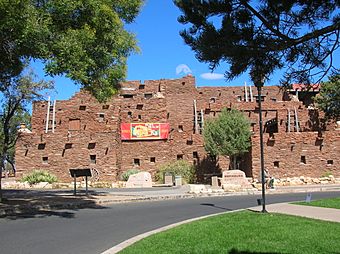Mary Jane Colter buildings facts for kids
|
Mary Jane Colter Buildings
|
|

|
|
| Location | Grand Canyon National Park, Arizona |
|---|---|
| Area | about 3 acres (1.2 ha) |
| Built | 1904 |
| Architect | Mary Colter |
| NRHP reference No. | 87001436 |
Quick facts for kids Significant dates |
|
| Added to NRHP | May 28, 1987 |
| Designated NHLD | May 28, 1987 |
The Mary Jane Colter Buildings are four special buildings located in Grand Canyon National Park in Arizona. They were designed by a famous architect named Mary Colter. These buildings were constructed between 1905 and 1932. They include Hermits Rest (built in 1914), Desert View Watchtower (1932), Lookout Studio (1914), and Hopi House (1905).
These buildings are great examples of Mary Colter's unique style. They also helped shape how buildings were designed in America's National Parks. Because they are so important, they were named a National Historic Landmark in 1987. This means they are recognized as very important places in American history.
Contents
Mary Colter's Grand Canyon Designs
Mary Colter was a very talented architect. She designed buildings that looked like they belonged in the natural landscape. She also took inspiration from ancient buildings. Her designs were very important for how other buildings in National Parks would look.
Where are the Buildings?
Two of the buildings, Hopi House and the Lookout Studio, are found in Grand Canyon Village. This is the main area where many park services are located. Hermit's Rest is a few miles west of the village, at the end of a paved road. The Desert View Watchtower is about 12 miles east of Grand Canyon Village. It is part of the Desert View Watchtower Historic District.
Who Built and Managed Them?
All four of these buildings were originally built by the Atchison, Topeka & Santa Fe Railroad. This railroad helped bring many visitors to the Grand Canyon. The buildings were then managed by the Fred Harvey Company. This company was well-known for its hotels and restaurants along railroad lines.
Colter's Unique Style
Mary Colter's designs were often influenced by old ruins from the American Southwest. You can see this in Hopi House and the Desert View Watchtower. She studied existing structures and ruins to create her designs.
Hopi House and Desert View Watchtower
Hopi House is a modern version of a traditional home of the Hopi people. It was designed to look like a Hopi pueblo. The Desert View Watchtower borrows ideas from many different ancient ruins. Inside the tower, you can even see copies of old rock art.
Hermit's Rest and Lookout Studio
In contrast, Hermits Rest and Lookout Studio were designed to blend in with their surroundings. This style made them look like they grew right out of the landscape. This idea of blending buildings with nature became very popular. Other architects working for the National Park Service later adopted this technique.



